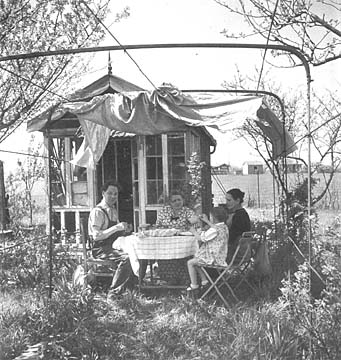
The architectural design process, largely dependent on vision, not surprisingly lavishes attention on the visual aspects of the building. But, how things look does not always tell us how they'll feel. The composition may be artful, the colors match, and the iconography too clever by half, but the place may be drafty, noisy, smelly, or just plain uncomfortable. The mate chosen only for physical beauty may have a foul temper, and when looks fade there may be nothing left to love. Comfort has no equivalent mathematical expression, no units, no standard constituents, no single sensory correlate. It can't be seen so it can't be drawn; and may be more important than anything that can.

"Getting comfortable" is a complex act with emotional and physical components, contextually and culturally sensitive, with an indeterminate path to get there, but an absolutely certain sense of arrival. We know when we are and we know when we're not. Comfort is a summary condition, the parts adding up to some kind of satisfaction. The simplest expression adds an antidote to current misery: if cold, to be warm; if hungry, to be fed. The parts needn't share the same units or derive from the same genus: comfort = I'm not too hot, the lunch was good, the sun is shining, and my work's going well.
We settle for what we can get. Without air conditioning on a hot day a slight breeze through an open window may be good enough, while a broken thermostat under similar conditions may be intolerable. But "good enough" depends on what we think we deserve and who might be looking. Status confers the right to complain, to act, to take scarce resources--just as a lack of status denies them. Happy is the one whose privilege it is to jockey the thermostat, and everyone else will adjust their tolerance accordingly.
If comfort is a sum, its parts are the balance between opposites or provide their own reason for being: room enough but not too much; neither hot nor cold (or damp); light to see and something to look at; a handy snack, a convenient toilet, and a parking spot. The freedom of choice needs something to choose: permeable boundaries which can be opened or closed between inside and outside, personal and public space, to hear and not be overheard, adjustable temperature, light and air.
Comfort is a summary of dynamic conditions, a pulsation of the good and not-so-good about the point of equilibrium. Steadiness, however perfect, is boring and dulls us to dissatisfaction. The Japanese sell fans which produce gusts or puffs of air to simulate natural breezes. Silence is golden when it is occasionally broken. The contrast of light and shadow is preferrable to flat and even lighting. Unremitting good taste is soporific and needs glitz to set its value. The perfect spring day, wonderfully comfortable, is both cool and warm, clear and dreamy, full of the promise of fulfillment without the demand for exertion. Comfort is like a catchy tune.
Comfort is the successful result of mutual adjustment--the new shoes gradually unstiffen and conform to the feet. But the familiar is not always comfortable--some shoes just never fit right. Nor do all shoes fit all feet. If the shoe fits, wear it--but not if it's on some other foot. When designers ask users how things should be made to make them most comfortable (or productive, etc.), the response is often what is familiar, even when it doesn't really fit---or what appears to be working elsewhere, even when it can't be made to fit. People will select and tolerate ill-fitting shoes when they feel the style is flattering. Design choices are often made the same way. The problem: shoes wear out much quicker than buildings; shoes can be slipped off under the desk when no one is looking; shoes can be easily changed.
Architects got more things right when they accommodated design
to natural environmental conditions. Sunshine and a nice breeze
make most rooms pleasant. Yet no one really wants to give up airconditioning
for it. Polling focus groups and interrogating potential users
may produce consensus instead of comfort; the blind may be leading
the blind. Lacking formulae and method we can only depend on experienced
and artful intuition.